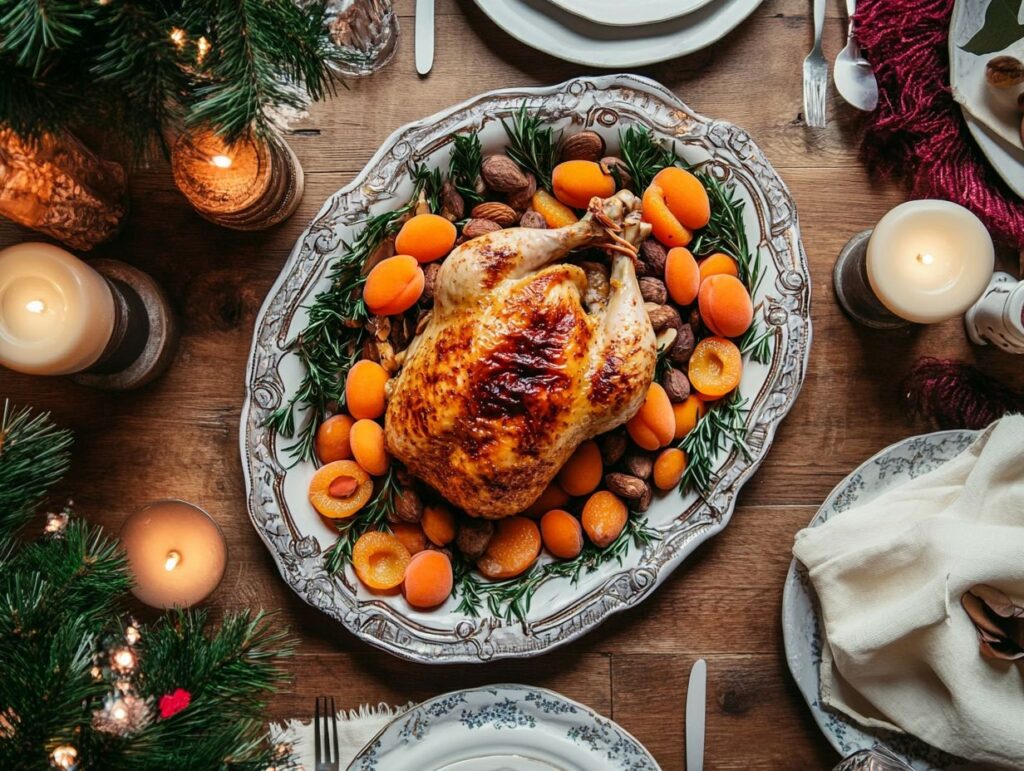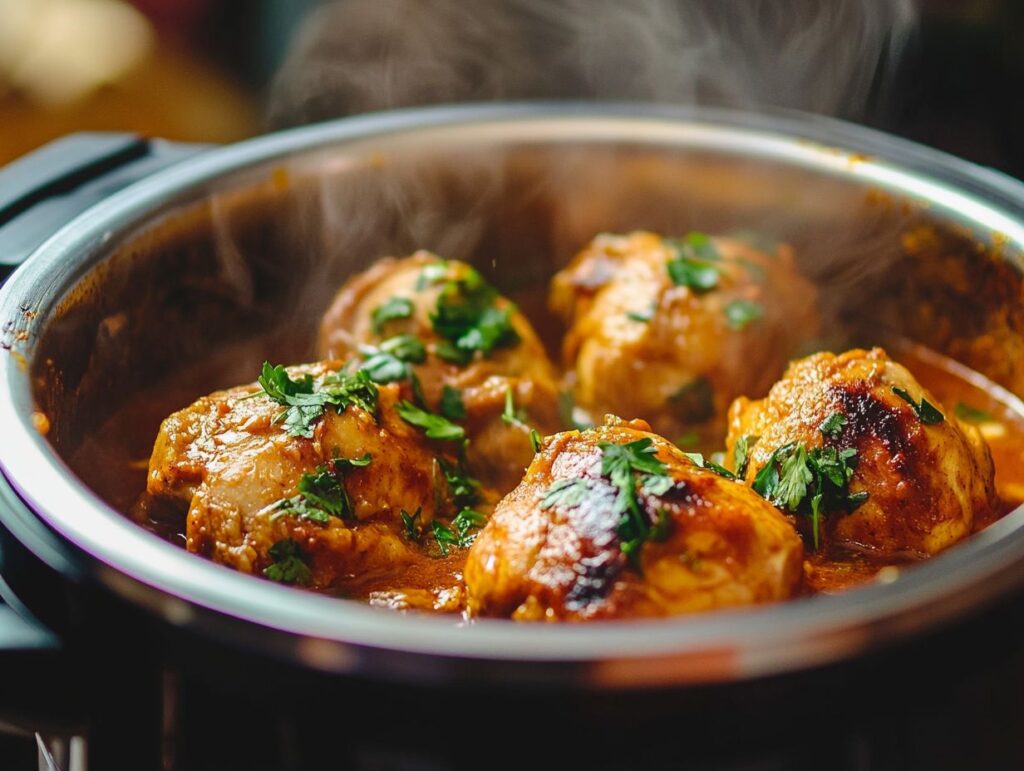The Best Fluffy Pancakes recipe you will fall in love with. Full of tips and tricks to help you make the best pancakes.

Moroccan cuisine is world-famous for its rich spices, bold aromas, and unique cooking techniques. And at the heart of this North African culinary tradition is the Moroccan chicken recipe—a dish that’s equal parts comforting and exciting. Whether you’re a first-timer or a seasoned home chef, this guide will walk you through everything from ingredients to cultural background and tips to mastering this flavorful dish.
In this article, you’ll explore traditional cooking methods, learn about the essential spices like ras el hanout, and discover regional variations like chicken with preserved lemons and sweet apricot-infused chicken. You’ll also find expert advice on pairings, storage, and even wine matching. Don’t miss our related recipe on how to build an authentic Moroccan experience at home: How to Make Moroccan Tagine
Let’s get started with the roots of the dish.
Introduction to Moroccan Chicken Recipe
What is Moroccan Chicken?
The Moroccan chicken recipe is a traditional dish made with chicken, spices, preserved lemons, and olives, often cooked slowly in a tagine. What sets this recipe apart is its rich, layered flavor built from North African spice blends and its slow-cooked, tender texture. Unlike typical roasted or fried chicken, Moroccan chicken is aromatic, infused with both savory and citrusy notes, and often accompanied by couscous or flatbread.
It’s a comforting yet vibrant dish that reflects Morocco’s cultural blend of Berber, Arab, and Mediterranean influences. Families prepare it for everyday dinners and festive occasions alike, making it both versatile and meaningful.
The Cultural Significance of Moroccan Cuisine
Moroccan cuisine goes beyond just taste—it’s a reflection of centuries of history, trade, and tradition. The ingredients in a Moroccan chicken recipe tell stories of ancient spice routes and cultural fusion. Spices like cumin, coriander, cinnamon, and saffron have long been prized in Moroccan kitchens, giving the chicken a flavor profile you won’t find elsewhere.
Sharing food is central to Moroccan culture. Meals are served family-style, often from a communal plate, with bread used to scoop up the meat and sauce. This style of eating not only emphasizes hospitality but also showcases how food can bring people together.
The popularity of Moroccan chicken recipes continues to grow in the West due to its bold flavors and relatively simple cooking process. It’s now a favorite for home cooks wanting something both exotic and accessible.
Ingredients Breakdown for Traditional Moroccan Chicken
Essential Spices and Seasonings
What sets a Moroccan chicken recipe apart is its vibrant, spice-forward profile. The dish typically features a rich blend of ground spices known as ras el hanout, which may include cumin, coriander, cinnamon, paprika, turmeric, ginger, and sometimes cardamom or nutmeg. These spices don’t just add flavor—they tell a story of Morocco’s history as a key player on ancient spice trade routes.
Garlic, onions, and fresh herbs like parsley and cilantro further enrich the dish. A pinch of saffron (if available) elevates the recipe with a golden color and subtle depth. Salt and black pepper round out the flavor base, creating the perfect balance of earthiness and warmth.
Protein Choices: Chicken Cuts and Alternatives
Traditionally, Moroccan families use whole chicken, cut into pieces, to ensure a mix of white and dark meat. However, you can easily adapt the recipe using bone-in chicken thighs or drumsticks, which stay juicy during slow cooking. Skin-on chicken is ideal for flavor, especially in tagine dishes where the meat slowly absorbs the spices.
For modern alternatives, skinless chicken breasts can be used for a leaner dish—though you may sacrifice some richness. Vegetarian adaptations swap the chicken for chickpeas or tofu, combined with the same spice base.
👉 Discover great ideas like these ingredient breakdowns in our article on Moroccan Tagine Ingredients
Classic Moroccan Chicken Cooking Techniques
Traditional Braising and Tagine Method
The most iconic way to cook a Moroccan chicken recipe is using a tagine, a conical-lidded clay pot designed for slow cooking. This method gently braises the chicken in its own juices, enhanced by spices, aromatics, and sometimes preserved lemons or olives. The tagine traps steam at the top, letting it drip back down, keeping the meat moist and full of flavor.
If you don’t own a tagine, a Dutch oven or heavy-bottomed pot with a tight lid works just as well. Slow cooking over low heat is key—allowing the flavors to develop slowly over time without boiling or drying the meat.
The process starts by sautéing onions and garlic, then browning the chicken before adding broth and spices. The pot is covered, and the dish is left to simmer gently until the chicken is tender enough to fall off the bone.
Stove-top, Oven, and Instant Pot Variations
For busy home cooks, modern appliances offer solid alternatives. On the stovetop, cook the dish in a deep pan with a lid for about 45 minutes to an hour. In the oven, use a covered baking dish at 350°F (175°C) for a similar time.
In a rush? The Instant Pot can cut cooking time to just 20–25 minutes under pressure. While you may lose a bit of the depth achieved in slow cooking, the result is still aromatic and tender.
👉 Check out how different tagine styles are prepared in this detailed guide: Moroccan Tagine Recipe

Step-by-Step Moroccan Chicken Recipe (With Measurements)
Preparing the Marinade
To start your authentic Moroccan chicken recipe, begin by creating a flavorful marinade. In a large bowl, mix:
- 2 tablespoons olive oil
- 1 teaspoon ground cumin
- 1 teaspoon ground coriander
- 1 teaspoon ground ginger
- 1 teaspoon paprika
- ½ teaspoon cinnamon
- ½ teaspoon turmeric
- Juice of 1 lemon
- 2 minced garlic cloves
- Salt and pepper to taste
Add 6–8 bone-in chicken pieces (thighs or drumsticks), coat thoroughly, and let marinate in the fridge for at least 1 hour—or overnight for deeper flavor.
Cooking and Garnishing the Chicken
In a deep skillet or tagine, heat 2 tablespoons of olive oil. Sauté 1 sliced onion until translucent. Add the marinated chicken and brown on both sides for 5–7 minutes.
Next, add 1 cup of chicken broth, 1 preserved lemon (quartered), and ½ cup green olives. Cover and simmer over low heat for 45–60 minutes, until the chicken is tender and cooked through.
Finish with a sprinkle of fresh chopped parsley and cilantro. Serve hot with warm bread or fluffy couscous.
This method preserves the rich spices and creates a sauce perfect for dipping.
👉 Don’t miss our classic variation featuring this technique: Moroccan Chicken Tagine
Regional Variations of Moroccan Chicken
Chicken with Preserved Lemon and Olives (Djej Mchermel)
One of the most iconic versions of the Moroccan chicken recipe is Djej Mchermel. This dish uses preserved lemons and green or purple olives, delivering a tangy, briny flavor that’s instantly recognizable in Moroccan households.
To prepare it, chicken is marinated with garlic, saffron, turmeric, ginger, and parsley, then slow-cooked with sliced onions, preserved lemons, and olives. The result is a bright, citrusy stew often served with warm flatbread to soak up the savory sauce.
This version is especially popular in Fez and Rabat, where preserved lemon is considered a signature ingredient in poultry dishes.
Sweet and Savory Chicken with Apricots and Almonds
In southern Morocco, particularly around Marrakesh, sweet elements are often blended with savory spices to create a comforting and festive meal. This variation features dried apricots, toasted almonds, and sometimes cinnamon and honey.
The chicken is browned and then slow-cooked with onions, broth, dried fruit, and a light dusting of sugar or honey. The final dish is beautifully caramelized with a rich sauce that balances sweet and savory perfectly.
This version is often reserved for special occasions or large family dinners, adding a touch of luxury to traditional flavors.
👉 Looking for inspiration? Try this modern take with bold flavor contrast: Sweet and Spicy Chicken
What to Serve with Moroccan Chicken
Couscous, Bread, and Other Moroccan Sides
No Moroccan chicken recipe is complete without the right side dish. The most traditional pairing is steamed couscous, especially when lightly flavored with olive oil, turmeric, and a pinch of cinnamon. It soaks up the chicken’s rich sauce beautifully and brings balance to the spices.
Another popular option is Khobz, Morocco’s round, rustic bread. It’s perfect for scooping up chicken and broth, especially in communal dining settings. The chewy texture of Khobz complements the tender meat and adds a satisfying bite.
For a heartier meal, consider saffron rice, barley pilaf, or even roasted potatoes seasoned with cumin and paprika. These absorb the sauce well while offering a bit more substance.
Moroccan Salads and Vegetable Pairings
To lighten the meal, a fresh Moroccan salad is ideal. The classic Tomato and Cucumber Salad—with chopped herbs, olive oil, and lemon juice—refreshes the palate. Grilled zucchini, carrots with harissa, or roasted eggplant also add flavorful, nutritious contrast.
Many Moroccan households also serve Zaalouk, a warm eggplant and tomato dip spiced with paprika and garlic. It’s often eaten with bread as an appetizer but doubles as a side with chicken.
These sides not only enhance flavor but also add cultural authenticity to your table.
👉 Check out this simple and delicious pairing idea: Easy Moroccan Couscous
Storage and Reheating Tips
How to Store Leftovers the Right Way
After enjoying your delicious Moroccan chicken recipe, proper storage is key to preserving its bold flavor and texture. Start by letting the dish cool to room temperature. Then, transfer the chicken and sauce into an airtight container.
Refrigerated leftovers will stay fresh for up to 4 days. Be sure to store it with the sauce, which helps the chicken remain moist. For longer storage, freeze the chicken in portions with broth in a freezer-safe bag or container—this method keeps the flavor intact for up to 3 months.
Label your containers with the date and contents so you don’t lose track of what’s inside your freezer.
Best Methods to Reheat Without Losing Flavor
The best way to reheat Moroccan chicken is low and slow. On the stovetop, place the chicken in a pan with a splash of water or broth. Cover and warm over low heat for 10–15 minutes until heated through.
In the microwave, use a microwave-safe dish, cover it loosely, and heat on medium power in 1-minute intervals, stirring or turning halfway.
Avoid high heat, which can dry out the chicken and separate the sauce. If reheating from frozen, let the dish thaw overnight in the fridge first.
👉 Discover more reheating-friendly ideas like this one: Sheet Pan Sausage and Potatoes
Health Benefits and Nutritional Profile

Nutritional Breakdown of a Moroccan Chicken Dish
A traditional Moroccan chicken recipe isn’t just flavorful—it can also be quite healthy. Chicken, especially when skinless, is a lean protein that supports muscle health and helps you feel full longer. When combined with olive oil, onions, garlic, and anti-inflammatory spices like turmeric and ginger, this dish becomes a nutrient-packed meal.
A standard serving (around 1 cup with sauce) contains approximately:
| Nutrient | Estimated Value |
|---|---|
| Calories | 350–400 kcal |
| Protein | 30–35g |
| Carbohydrates | 8–10g (from onions/spices) |
| Fat | 18–22g (mostly healthy fats) |
| Fiber | 2–3g |
This makes it a great option for people looking for low-carb meals, especially when paired with vegetables instead of couscous or bread.
Low-Carb and Gluten-Free Adaptations
To make your Moroccan chicken recipe even healthier, try serving it with cauliflower rice, quinoa, or a chickpea salad. These sides are naturally gluten-free and add fiber without processed carbs.
Avoid store-bought spice blends with hidden sugar or sodium—making your own ensures a clean, wholesome meal.
With the right swaps, this traditional recipe fits Mediterranean, Paleo, and Keto diets easily.
👉 Explore another nutritious, plant-based dish: One Pot Chickpea Curry
What makes Moroccan chicken different from regular chicken dishes?
The Moroccan chicken recipe stands out for its complex flavor, built from spices like cumin, coriander, cinnamon, turmeric, and ginger. It’s often cooked slowly in a tagine with preserved lemons and olives, giving it a unique mix of savory, tangy, and slightly sweet notes.
Can I make Moroccan chicken ahead of time?
Absolutely. In fact, it often tastes better the next day. Letting the chicken rest overnight allows the spices to deepen. You can marinate it in advance or fully cook it, then store it in the fridge for up to 4 days.
What’s the best substitute for preserved lemons?
If you can’t find preserved lemons, use a mix of fresh lemon zest and salt, or lemon juice with a splash of apple cider vinegar. It won’t be identical, but it gives a similar acidic brightness to the dish.
Is Moroccan chicken spicy?
No, not necessarily. Moroccan food is more about aromatic spice than heat. However, you can add chili flakes or harissa if you like a bit of kick.
Conclusion: Ready to Try This Moroccan Chicken Recipe at Home?
Bringing the flavors of Morocco into your kitchen is easier than you might think. With its fragrant spices, tender chicken, and rich cultural roots, this Moroccan chicken recipe delivers both comfort and complexity. Whether you’re using a traditional tagine or a modern Instant Pot, the result is always satisfying.
From everyday dinners to festive meals, Moroccan chicken adapts beautifully to different occasions. Don’t be afraid to experiment with sides, spice levels, or even protein swaps.
If you’re looking for more inspiration to complete your Moroccan menu, don’t miss our vibrant salad idea: Avocado Egg Salad—it pairs beautifully with warm North African spices.
Now it’s your turn. Gather your ingredients, light up your stove, and start cooking a dish that tells a story with every bite.
PrintMoroccan Chicken Recipe: The Ultimate Guide to Authentic Flavor
This Moroccan chicken recipe is slow-cooked with preserved lemon and olives.
Ingredients
– 6-8 bone-in chicken pieces (thighs or drumsticks)
– 1 preserved lemon, quartered
– 1/2 cup green olives
– 2 tbsp olive oil
– 1 tsp ground cumin
– 1 tsp ground ginger
– 1 tsp paprika
– 1/2 tsp ground cinnamon
– 1 tsp turmeric
– 2 garlic cloves, minced
– 1 onion, sliced
– 1 cup chicken broth
– Salt and pepper to taste
– Chopped parsley and cilantro (for garnish)
Instructions
In a bowl, combine all spices, olive oil, lemon juice, and garlic. Add chicken and marinate for at least 1 hour.
Heat olive oil in a tagine or skillet. Sauté onions until translucent. Add chicken and brown on all sides.
Add broth, preserved lemon, and olives. Cover and simmer 45–60 minutes on low heat.
Garnish with chopped parsley and cilantro. Serve hot with couscous or bread.
Notes
Aggregate Rating : 4.9
Review Count : 125
Nutrition
- Serving Size: 1 plate (approx. 350–400 g)
- Calories: 380 kcal
- Sugar: 3 g
- Sodium: 680 mg
- Fat: 20 g
- Saturated Fat: 4 g
- Unsaturated Fat: 14 g
- Trans Fat: 0 g
- Carbohydrates: 9 g
- Fiber: 2 g
- Protein: 33 g
- Cholesterol: 110 mg
Keywords: Moroccan chicken recipe, tagine chicken, preserved lemon chicken



